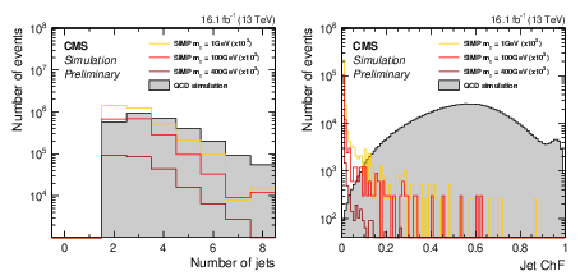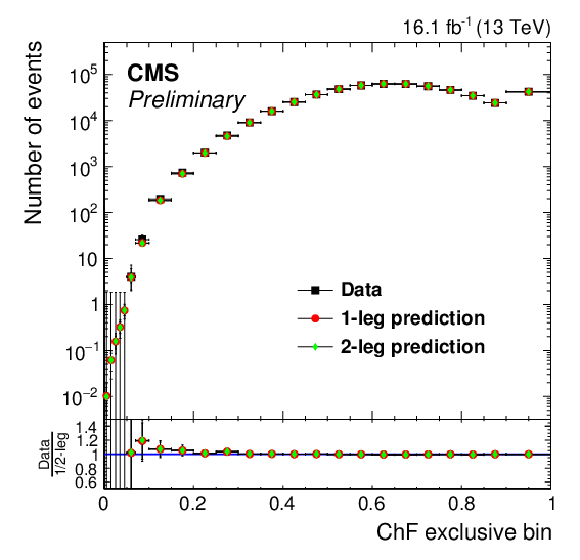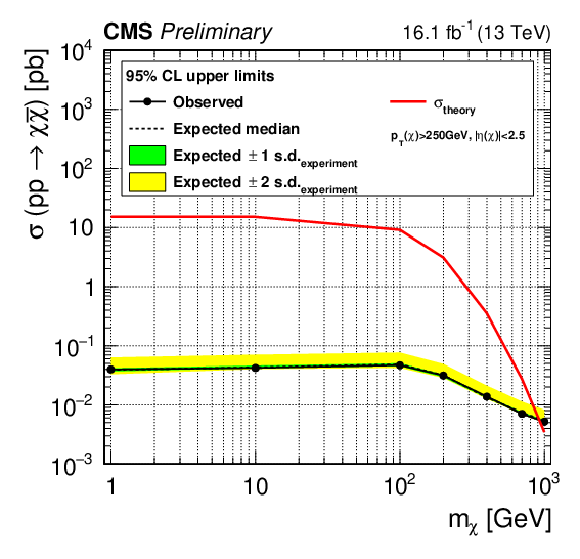

Compact Muon Solenoid
LHC, CERN
| CMS-PAS-EXO-17-010 | ||
| Search for strongly interacting massive particles with trackless jets | ||
| CMS Collaboration | ||
| July 2020 | ||
| Abstract: A search for dark matter in the form of strongly interacting massive particles, manifesting themselves as a pair of jets without tracks in the CMS detector at the LHC, is presented. The charged energy fraction of jets is used as a key discriminator to efficiently suppress the large multijet background, and the remaining background is estimated directly from data. The search is performed using proton-proton collision data corresponding to an integrated luminosity of 16.1 fb−1, collected by the CMS detector in 2016. No significant excess of events is observed above the expected background. Strongly interacting massive particles with masses up to 900 GeV are excluded at 95% confidence level for the model under consideration. The presented analysis thus evaluates the sensitivity to an unconventional phase space for new physics for the first time at colliders. In addition to the interpretation in the context of the SIMP model, model-independent limits that can be used for reinterpretation of the results are provided. | ||
|
Links:
CDS record (PDF) ;
CADI line (restricted) ;
These preliminary results are superseded in this paper, Submitted to EPJC. The superseded preliminary plots can be found here. |
||
| Figures | |

png pdf |
Figure 1:
Feynman diagram showing the production of a SIMP pair, through a new low mass mediator. |

png pdf |
Figure 2:
Number of jets with pT> 30 GeV (left) and ChF of the two leading jets (right). The baseline selection is applied, except for the requirement on the number of jets in the corresponding plot. The QCD and SIMP simulations are normalized to 16.1 fb−1. |

png pdf |
Figure 2-a:
Number of jets with pT> 30 GeV. The baseline selection is applied. The QCD and SIMP simulations are normalized to 16.1 fb−1. |

png pdf |
Figure 2-b:
ChF of the two leading jets. The baseline selection is applied, except for the requirement on the number of jets. The QCD and SIMP simulations are normalized to 16.1 fb−1. |

png pdf |
Figure 3:
Closure test in MC, as a function of inclusive ChF<x bins. |

png pdf |
Figure 4:
The 1- and 2-leg predictions from data, as well as the direct observation in data, as a function of exclusive bins in ChF, where either the leading or the subleading jet has a ChF within the bin range, and both have a ChF below the upper threshold. |

png pdf |
Figure 5:
The expected 95% CL upper limits on the production cross section for SIMPs with masses between 1 and 1000 GeV, as well as the theoretical prediction (red), with respect to the generator level selection (pχT> 200 GeV and |ηχ|< 2.5). |
| Tables | |

png pdf |
Table 1:
Number of predicted (using the 1-leg prediction from data) and observed events for the considered selections. The expected number of signal events is also given for the mχ= 1 GeV and mχ= 1000 GeV scenarios, with the corresponding statistical uncertainties. |

png pdf |
Table 2:
The systematic uncertainties taken into account for the signal simulation. |
| Summary |
| A search was presented for dark matter in the form of strongly interacting massive particles (SIMPs) manifesting themselves in the detector as a pair of jets without tracks. The large multijet background is efficiently suppressed using the charged energy fraction of jets as the key discriminator. The remaining background is estimated directly from data. Using proton-proton collision data corresponding to an integrated luminosity of 16.1 fb−1 of integrated luminosity collected by the CMS experiment in 2016, we set first limits on a potential SIMP signal, excluding SIMP masses up to 900 GeV at 95% confidence level. A model-independent fiducial cross section upper limit of 0.18 fb at 95% confidence level is also provided for a generic fiducial signal of high-momentum trackless jets. The presented analysis thus evaluates the sensitivity to an unconventional phase space for new physics for the first time at colliders, providing both the interpretation in the context of the SIMP model, as well as model-independent limits that can be used for reinterpretation of the results. |
| References | ||||
| 1 | E. W. Kolb and M. S. Turner | The Early Universe | Front. Phys. 69 (1990)1 | |
| 2 | G. Bertone and D. Hooper | History of dark matter | Rev. Mod. Phys. 90 (2018), no. 4, 045002 | 1605.04909 |
| 3 | N. Daci et al. | Simplified SIMPs and the LHC | JHEP 11 (2015) 108 | 1503.05505 |
| 4 | ATLAS Collaboration | Search for long-lived neutral particles in pp collisions at √s= 13 TeV that decay into displaced hadronic jets in the ATLAS calorimeter | EPJC 79 (2019), no. 6, 481 | 1902.03094 |
| 5 | J. H. Davis | Probing Sub-GeV Mass Strongly Interacting Dark Matter with a Low-Threshold Surface Experiment | PRL 119 (2017), no. 21, 211302 | 1708.01484 |
| 6 | CRESST Collaboration | Results on MeV-scale dark matter from a gram-scale cryogenic calorimeter operated above ground | EPJC 77 (2017), no. 9, 637 | 1707.06749 |
| 7 | EDELWEISS Collaboration | Searching for low-mass dark matter particles with a massive Ge bolometer operated above-ground | PRD 99 (2019), no. 8, 082003 | 1901.03588 |
| 8 | D. Hooper and S. D. McDermott | Robust Constraints and Novel Gamma-Ray Signatures of Dark Matter That Interacts Strongly With Nucleons | PRD 97 (2018), no. 11, 115006 | 1802.03025 |
| 9 | T. Emken and C. Kouvaris | How blind are underground and surface detectors to strongly interacting Dark Matter? | PRD 97 (2018), no. 11, 115047 | 1802.04764 |
| 10 | CMS Collaboration | The CMS experiment at the CERN LHC | JINST 3 (2008) S08004 | CMS-00-001 |
| 11 | CMS Collaboration | Particle-flow reconstruction and global event description with the CMS detector | JINST 12 (2017), no. 10, P10003 | CMS-PRF-14-001 1706.04965 |
| 12 | M. Cacciari, G. P. Salam, and G. Soyez | The Anti-k(t) jet clustering algorithm | JHEP 04 (2008) 063 | 0802.1189 |
| 13 | M. Cacciari, G. P. Salam, and G. Soyez | FastJet user manual | EPJC 72 (2012) 1896 | 1111.6097 |
| 14 | CMS Collaboration | Jet energy scale and resolution in the CMS experiment in pp collisions at 8 TeV | JINST 12 (2017), no. 02, P02014 | CMS-JME-13-004 1607.03663 |
| 15 | CMS Collaboration | Description and performance of track and primary-vertex reconstruction with the CMS tracker | JINST 9 (2014), no. 10, P10009 | CMS-TRK-11-001 1405.6569 |
| 16 | CMS Collaboration | Technical proposal for the phase-ii upgrade of the compact muon solenoid | CMS-PAS-TDR-15-002 | CMS-PAS-TDR-15-002 |
| 17 | CMS Collaboration | Performance of Photon Reconstruction and Identification with the CMS Detector in Proton-Proton Collisions at √s= 8 TeV | JINST 10 (2015), no. 08, P08010 | CMS-EGM-14-001 1502.02702 |
| 18 | A. Alloul et al. | FeynRules 2.0 - A complete toolbox for tree-level phenomenology | CPC 185 (2014) 2250 | 1310.1921 |
| 19 | J. Alwall et al. | The automated computation of tree-level and next-to-leading order differential cross sections, and their matching to parton shower simulations | JHEP 07 (2014) 079 | 1405.0301 |
| 20 | T. Sjostrand et al. | An Introduction to PYTHIA 8.2 | CPC 191 (2015) 159 | 1410.3012 |
| 21 | CMS Collaboration | Event generator tunes obtained from underlying event and multiparton scattering measurements | EPJC 76 (2016), no. 3, 155 | CMS-GEN-14-001 1512.00815 |
| 22 | GEANT4 Collaboration | GEANT4: A Simulation toolkit | NIMA 506 (2003) 250 | |
| 23 | CMS Collaboration | The CMS trigger system | JINST 12 (2017), no. 01, P01020 | CMS-TRG-12-001 1609.02366 |
| 24 | A. L. Read | Presentation of search results: the cls technique | JPG 28 (2002) 2693 | |
| 25 | T. Junk | Confidence level computation for combining searches with small statistics | NIMA 434 (1999) 435 | hep-ex/9902006 |
| 26 | CMS Collaboration | CMS Luminosity Measurements for the 2016 Data Taking Period | CMS-PAS-LUM-17-001 | CMS-PAS-LUM-17-001 |

|
Compact Muon Solenoid LHC, CERN |

|

|

|

|

|

|